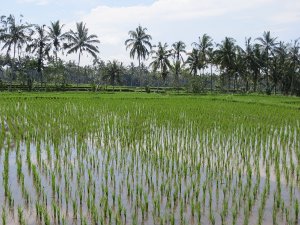A Walk Around the Ubud Rice Fields
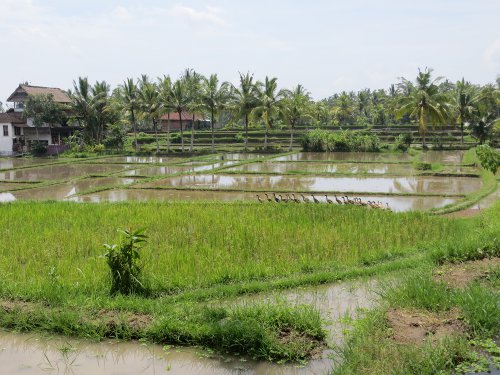
While gazing into the rice fields in Ubud, Bali, Indonesia we were fortunate to meet Wayan, a 47-year-old farmer that welcomed us to enjoy a closer view of his land with a sweet smile and the refreshing taste of his coconuts through an organic bamboo straw.
Wayan has always lived in Ubud and he has never left Bali. Before him, his land was already growing rice under the caring hands of his grandfather and great grandfather. Planting rice is a family tradition for Wayan and many others in Ubud. He guided us on a 4-hour hike around the rice fields. The fields we visited are 2 kilometers north from Ubud city center and we walked a total loop of 8 kilometers around these engineering master pieces of life and running water.

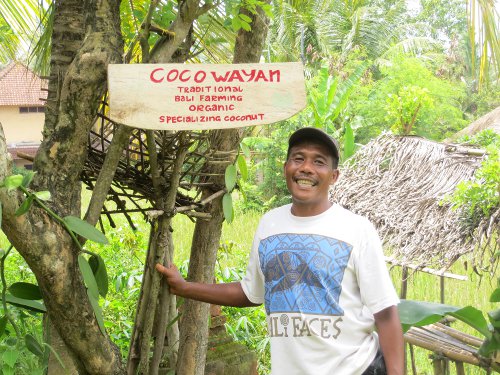
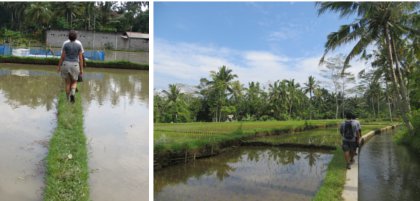
During our walk, Wayan educated us about the process of planting rice. Growing rice takes about 120 days to harvest. Rice is planted and harvested twice a year in Ubud. Planting seasons are between January-February and July-August while harvesting time is around April-May and October-November, respectively. Wayan explained that his rice production is only for self-consumption and with it he has enough to feed his family during the entire year. Wayan’s family includes his wife, two children, and his parents.
Before planting the rice, the soil has to be weeded and turned. Wayan and many other farmers in the area rent a small tractor to prepare the soil. He explained that tractors are making their work faster and easier. A lot of rice farmers also raise ducks in their fields because they are helpful in the process of weeding and fertilizing the land, as well as produce eggs for daily consumption and yield a second source of income when they are sold to the local restaurants.
Rice is planted first on a small and protected section of the field. After 15 days, when the rice has grown a few centimeters and is strong enough, the “baby rice,” as Wayan called them, are separated and transplanted linearly in the dry fields. Water is slowly allowed into the rice fields for the next 105 days while farmers observe and protect the growing plants. At this time, when the rice starts to look golden, the plants are harvested. From then, rice is left out in the sun to dry, stored, and eventually taken into a milling process where the husk and bran layer of the rice is removed. Wayan explained that farmers pay for their rice to get milled by a special machine and that the process does not take long.
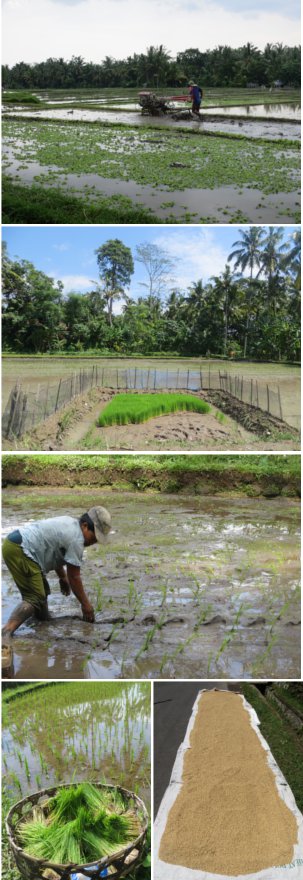
Wayan talked to us about the way in which tourism has changed the lives of people in Ubud during the last 10 years. He said before tourism was so strong, being a farmer was the only job for men and women in the area. Now, tourism has brought other employment opportunities for them and being a farmer is not the only way of living. He explained that before tourism the Ubud population was more physically active and healthy, but now due to their lifestyle changes diseases like diabetes are starting to appear early in life.
“Another house from the Westerners,” Wayan said with sadness while showing us the huge retirement houses that foreigners are building in the middle of the rice fields. “They don’t know what they are doing and they are making a mistake. Tourists come to Ubud because they love nature, our traditions, and rice fields. By selling the land they are taking away the reason why tourists come.” Wayan explains that most of the rice fields are owned by the “kingdoms” and not the farmers. Rich people in Bali are the ones making the decision of selling the land. He also referred to being lucky to own his land and stated that he will never sell it. For foreigners the beautiful views of the rice fields are an exotic place to enjoy their retirement, but for families in Ubud this land represents their identity and entire source of living for generations. No money should be enough to pay and destroy the history of an entire community. After a few months of traveling, we continue wondering how much damage has to be done before we can learn to respect other people’s culture and stop trying to interfere.


It was clear that Wayan is not against tourism in Bali. By taking us on a walk around Ubud and teaching us so much about his surroundings, he gave us a good taste of what tourism should look like: a respectful experience of enjoying and learning about a new place that you try to leave as if you were never there. Wayan taught us about many other plants that grow around the rice fields, educating us about their nutritional and medicinal properties. We were able to see cocoa, coffee, bananas, vanilla, papaya, snake skin fruit, lemongrass, durian, jackfruit, sweet potato, cassava, cucumbers, coconuts, and clove trees. He also told us how Arak, a traditional alcoholic drink from the flower of coconut trees, and rice wine are made.
Wayan was open to share with us about his culture and religion, explaining that in Hinduism, money is only use for three purposes: food, children’s education, and God offerings. “And this is why we Hindu people are happy people, no money is needed for anything else,” Wayan said. He also explained that names are given to children by birth order, and all first born, male or females, are named Wayan. He talked to us about the Saraswati celebration (God of Creativity and Education) at the temple that took place the day before our hike. Wayan explained how the new and full moons are important days of celebration in the temple for Hindus.
Wayan’s generosity filled us with knowledge and unforgettable views in just a few hours of hiking. Meeting him made our trip to Indonesia a real experience that we will remember for the rest of our lives. Per his request, we are posting his picture in this article as he is hoping for some publicity and mindful tourism in Bali. We are sure he will be happy to take you on a walk 🙂
